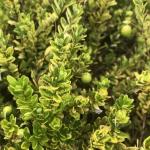Current conditions are prime for seeing yellow vine syndrome symptoms, which are typically expressed when vines are under stress, usually from heat or water imbalances. There is not much to do at this point except to monitor soil moisture and irrigate regularly as needed. See photo for example of leaf symptoms.
Mid-day cooling could be an option when hot days are present. Exposed berries (higher in the canopy) are more at risk for scald development. Running for mid-day cooling is always a balance between running long enough to take advantage of the evaporative cooling but not so long that your increase the moisture in the soil and increase your risk for fruit rot. If the heads on your sprinkler system complete their rotation quickly, that is advantageous as you get the evaporative cooling effect in a short time frame.
The irrigation system can shut down sooner and minimize the increase in soil moisture. With older systems and/or those with slow rotating heads, the opposite is true, and the balance is harder to maintain.
The stage of fruit development is also important when considering evaporative cooling. Fruit are more susceptible to scald later in the season when color formation starts. This might possibly be due to anthocyanin being less efficient at converting sunlight compared to chlorophyll in greener fruit.
Consider purchasing an infrared thermometer to see what the temperature of the fruit is. An inexpensive thermal camera is also a good alternative. This could help you decide whether you should think about running your irrigation or not. The decision to run should be based on the temperature threshold for occurrence of scald. A study published out New Jersey has shown this to be 80 °F or higher for ambient temperature (Croft, 1995). In terms of canopy and mid-canopy temperature, this translates to 98 °F and 106 °F, respectively.
Sparganothis (see photo below) is big enough to see now and to see the damage. If you see red berries, open them up and look for the culprit. If it is sparganothis fruitworm, they are pale yellow, whitish larvae that wiggle if you touch them. They throw their feces outside the berry and feeding inside is fairly clean.
If the larvae are more green and rather sluggish, it is likely a cranberry fruitworm. They leave their feces inside the berry and are often sealed inside with a silk door over their entrance.
Both sparganothis and cranberry fruitworm are about half grown, not even 1/4" in size. In either case, now would be the time for Delegate if you are going to use it.
Remember when using Callisto, you are only permitted only 2 applications total to the bog area. This counts whether applied by boom, chemigation or any combination of application methods. Even if you only apply 4 oz/A each time (thus staying under the 16 oz/A limit), you can only make 2 applications. If you chemigated Callisto and If a portion of your bog did not get treated for some reason (blocked head, etc) and you have weed escapes, you can spot-treat that portion of bog. You should carefully note this in your pesticide records, so it does not read as 3 applications to the same piece. Keep in mind, the Special Local Needs label (SLN) for the concentrated spot treatment is associated with the Callisto label, not other mesotrione products. Callisto has a 45-day PHI. Poast has a 60-day PHI.
Sul-Po-Mag or K-Mag can be used to help vines recover from fairy ring stress when applied mid-August through October.
We will be offering a 1-hr workshop on August 9 from 9-10 am via zoom. One pesticide contact hour will be available. Please contact Robyn Hardy (rmhardy@umass.edu) for link information.

